Data-driven AI: the solution for generating people-oriented SEO content
Tabla de Contenidos
What is Data-Driven AI? Data-driven AI is a type of generative AI that generates content based on user search data. It’s a concept that we created in Keytrends in 2022 searching for quality results and avoiding the hallucinations generated by general generative AI.
Yes: Keytrends is the first SaaS tool that uses this user & data centred vision to generate content. In this guide, among other things, we are going to explain our vision and our way to orient the content
The basic problem that we must clarify is that we cannot leave the creation of content in the hands of a model that uses probability, because even if it adopts an increasingly human tone and language, it is not going to solve or cover the problem adequately.
The main focus of any content should be to solve an information need or a search intention if it comes from Search. Therefore, if we do not first analyse that search, that need and land it by converting it into data, we will not be able to automate the response as a person who follows the logical process of research, documentation and content writing.
Hence our obsession with understanding the need and search intent first and automating the research process to give the right inputs to the AI before we start generating content.
This is the approach we adopted at Keytrends from the beginning and the one that AI text generators are slowly evolving towards. But as of today, most of them are still generic, non-data-driven tools, so let’s start this guide by looking at why they don’t work, what studies prove it and what data-driven AI content platforms exist.
Human vs AI content: why generative AI or ChatGPT generates worse content
We have already said it: AI as we know it today does not work to generate content for our content marketing and SEO strategies.
And it doesn’t for two reasons:
- Generative AI writing is (still) far from being human-like: it is still too generic and continuously hallucinates.
- AI-generated texts achieve lower visibility in SERPs compared to human-written content if they do not meet the requirements of search engines like Google in terms of quality and usefulness of the content.
Let’s break these two points down further:
1. The AI generates content by probability and is prompt-dependent.
Roughly speaking, generative AI is a type of artificial intelligence that creates new content based on patterns learned from existing data. Thanks to this, the generative AI model is able to identify what kind of response it should give depending on the command it receives (what we know as prompt) and the probability. And it will do so by creating new information, as in the case of text generative AI.
There are two problems with this operation:
- It always replicates the same patterns and, therefore, the answers are generic. The solution is to issue a command or prompt as detailed as possible so that the text-generative AI returns more specific and accurate answers.
- It will not generate a different point of view to an issue to create a unique and original response, because it is based on data that already exists: “AI tools are still in the development phase, and they can only generate content based on existing data. It might not be possible for an AI tool to generate something new and unique for your site. An AI tool cannot think creatively for itself; it needs some human input to do this” (Becoming Human).
Microsoft itself warns about this in its FAQ on Copilot:

There would still be a third problem: the hallucinations and data that are not infrequently invented by generative AI. But this deserves a separate section.
2. AI has hallucinations and does not always give true data
AI hallucinations are a phenomenon of large language models (LLMs) that occurs when the answers they give contain information that appears to be true, but is not.
A hallucination is the generation of content that is nonsensical or unfaithful to the provided source
Why are LLMS models produced and hallucinated? LLMS have been trained to predict tokens. They base the generated content on probabilities and do not know if the generated content is correct or incorrect, true or false. Sometimes it is the training database that is insufficient or inappropriate.
As Xabier Amatrian comments in his hallucinations study, these hallucinations are improved with the following training given to the LLMS, which is RLHF (Reinforcement Learning from Human Feedback) and thus improve their quality and factuality.
For example: an AI that specialised in generating contracts for the financial sector may intuit and create contracts for other sectors by probability but it is very likely to hallucinate and make up data. Ultimately, it will generalise and apply the patterns it has learned to unfamiliar orders, as Telus points out: “The goal of ML model training is to generalise from training instances so that the model can correctly operate on instances it hasn’t seen before”.
Hallucinations are a major handicap that can bring sensitive areas of people’s lives into play, including their health. For example, this study from the scientific journal Cureus, in which ChatGPT provided information that had not yet been tested and documented: “ChatGPT, with apparent confidence, provided an essay on liver involvement which, in reality, has not been reported yet” (screenshot below). In addition, in this case Chat GPT made up bibliography references when asked to do so.
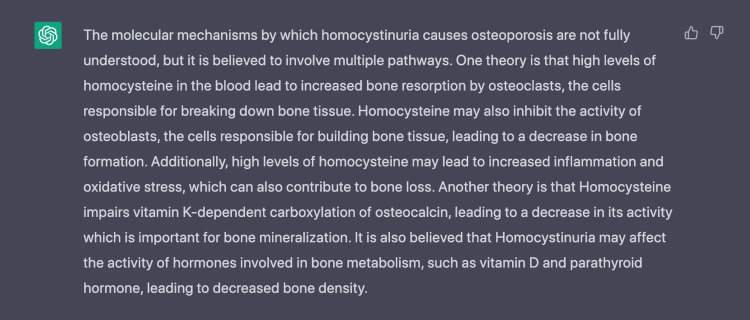
How to reduce hallucinations to generate more useful and factual content?
Some techniques to reduce these hallucinations in a generative AI product like Keytrends are:
- Cite sources and references to documents or papers that will also help the user experience and EEAT.
- Indicate to the user that the generated content is a sample of content and that the responsibility for publication rests with in the end user
- Be able to modify the content at any time
- Be able to refine the result by adding more prompts systems. In our case we use Keychat to be able to iterate on the content and a series of predefined prompts with a more concise scope.
- Limit the answers to a few paragraphs
- Structure the content in content briefs and feed it with data from user research.
- Use documentation or Knowledge base to be able to research on a topic and make prompts and questions on a closed and verified documentation.
These and other techniques are what we apply at Keytrends so that you can have higher quality results for the user.
Other hallucination reduction techniques are:
- Adjusting meta-indications. For example, provide more context in the first prompts before asking for a final result.
- Repeating key elements in an assertive tone (e.g. capitalization) to emphasize their importance.
- Passing in context factual facts or statements about the topic
- Execute a chain of thought by means of manual TOC
- REACT prompting (reacting) Use the REACT model to generate previous reasoning
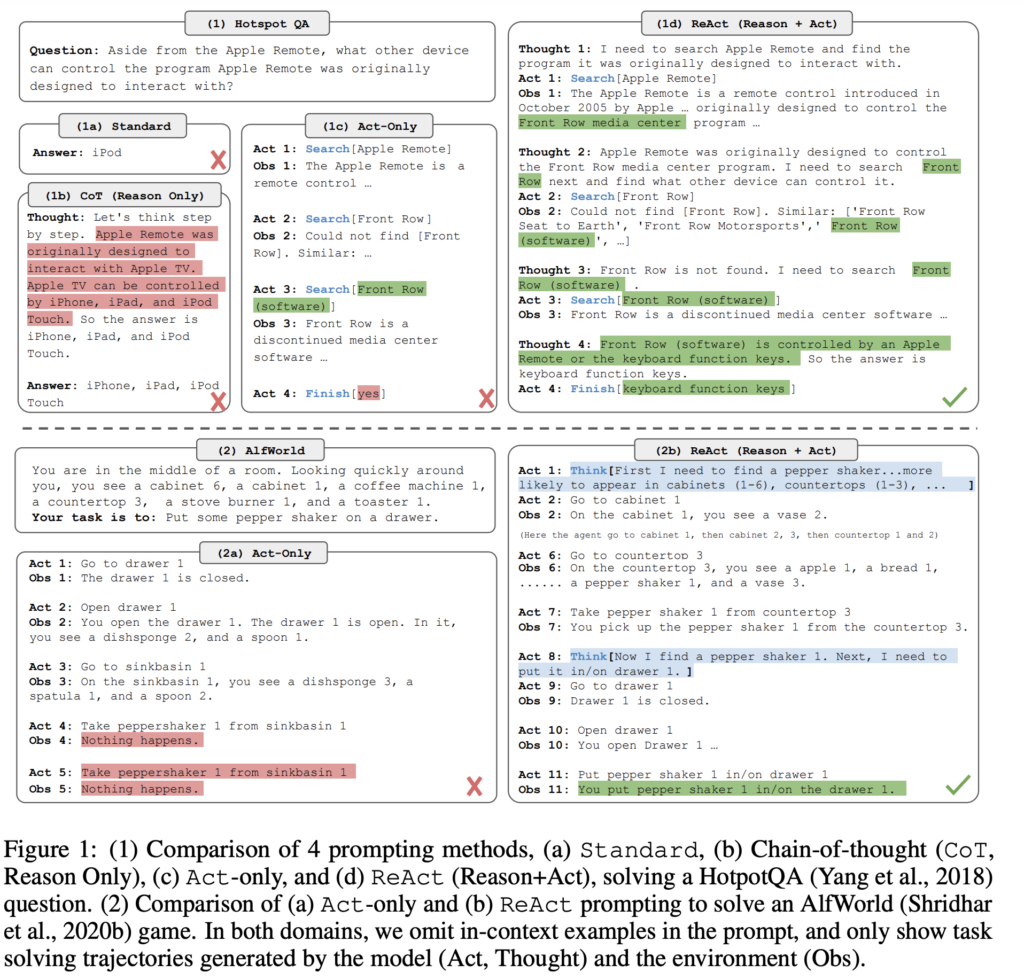
- Chain of Verification (COVE)
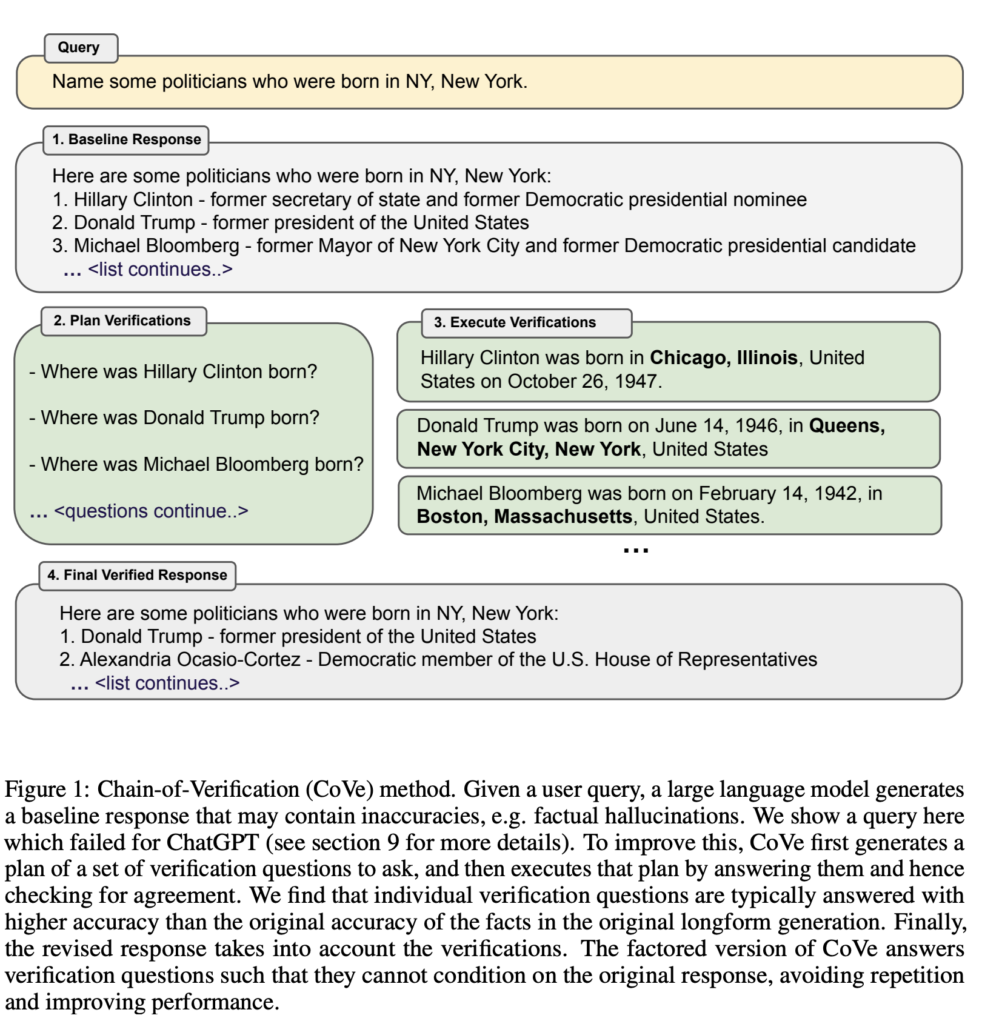
3. AI is a black box for us: where are the references?
Not knowing where the information for AI responses comes from is a problem that is compounded by the phenomenon of hallucinations. If we work in a highly specialised sector, wouldn’t it be ideal if the generative AI tool we use has been trained with authoritative sources in the field?
By the end of 2023, more and more AI search engines, chat rooms and co-pilots will include the source from which the information has been extracted (Bing Chat, Perplexity.ai, YouChat, Bard), but it remains human responsibility to verify that the information is true and that the source is reliable (one of the requirements for Google’s E-E-A-T).
➡️ Hotjar’s editorial study that pits ChatGPT against a human copywriter
There are several studies that illustrate all of the above points. Lesley Marchant, editor of Hotjar, put ChatGPT to the test to write a 2,000-word article on the effects of AI on various industries. At the same time, she commissioned her trusted copywriter to write the same piece. The study is based on comparing the performance of the AI and the human author on various tasks and/or aspects of writing.
The experience of the Hotjar editor generating an article with the help of ChatGPT compared to a human writer can be summarised in this table:
| Task | ChatGPT | Human copywriter |
| Outline | ❌ Ignore initial prompt ❌ Shorten the length ❌ Provide false data ❌ Need to set prompt | ✅ No additional information required ✅ Full schematic content available for next day |
| Execution time | ✅ 80m | ❌ 19h of research and writing |
| Cost | ✅ Free | ❌ Under payment |
| Draft editing | ❌ 3.5h of corrections | ✅ Ready in 40m |
| Voice and tone | ❌ Generic ❌ Not storytelling ❌ Not very innovative | ✅ Use brand tone and voice ✅ Copywriting techniques |
| Context | ✅ Verifiable examples ❌ Outdated information | ✅ Approves fact-checking ✅ Current data |
ChatGPT wins on execution time and cost, but “does it have the style and substance of something written and edited by professional content marketers?”, the answer is NO.
ChatGPT’s lack of style results in a boring text that would lead to a lousy user experience: “Almost half of the sentences in ChatGPT’s piece follow the same structure. As you can imagine, this repetitive structure could put any reader to sleep”.
On top of a negative user experience, joins the outdated data and the need to adjust the instructions given due to prompt-dependency.
Would Google give visibility to such content? Let’s take a look at what Google requires of AI-powered content and the results of a study by an online marketing agency .
What Google requires of AI-written content for ranking
First of all: Google does not penalise this type of content or condemn AI as long as it is used correctly: “Appropriate use of AI or automation does not violate our guidelines”. That is, we are referring to content that is not primarily used to manipulate search rankings, which violates our Spam policies”.
In other words, as long as the content is created to be useful to the user, it doesn’t matter whether it is created with the help of artificial intelligence. Confirmation of this can be found in the Helpful Content Update guidelines. Google has already changed it in its English version: where it used to read “written by people and optimised for users“, it now only reads “created for people“, with no mention of the type of creator.
It is worth noting that Google recommends adding a note in the content that responds to how the article was created (if, for example, we have used AI for the research or structuring of the article). What would you do?
Going by their official guidelines, what Google will require of all content, both human and AI, will be: other purposes rather than only positioning, avoiding spam and misuse of generative AI and aiming to generate a high EEAT content.
1. AI-generated content should not be solely for the purpose of positioning
Danny Sullivan reiterates in a tweet:
We haven't said AI content is bad. We've said, pretty clearly, content written primarily for search engines rather than humans is the issue. That's what we're focused on. If someone fires up 100 humans to write content just to rank, or fires up a spinner, or a AI, same issue…
— Danny Sullivan (@dannysullivan) November 7, 2022
This is nothing new and Google’s Guide to Creating Useful, Reliable and People-Centric Content explains the difference. In this table we summarise the most important points that differentiate each:
| Content created for people 🧑🦰 | Content created for search engines 🕷️ |
| ✔️ Content of interest for an already captured audience. | 〰️ Those that only summarise the content of others and do not add value, which denotes that they deal with a subject without knowing it and without being experts. As a result, people feel they need to search further after reading the site. |
| ✔️ Content people feel they have learned and can achieve their goal without the need to look any further. | 〰️ Often, these sites are multi-themed because their goal is to get visitors. They resort to automation in order to publish more. |
| ✔️ Content written from experience and based on in-depth knowledge, often on websites that deal with a specific topic rather than several. | 〰️ Content that deals with trending topics rather than content that is useful. |
| ✔️ Overall, both the content and the website offer a satisfactory user experience. | 〰️ Content that “promises to answer a question that has no answer”. |
Incidentally, Bing has a similar position on AI content and in its webmaster guidelines not only points out this very idea, but also qualifies the automatic generation of content as a malicious practice that can lead to penalties:

Bing has a responsible AI policy available for consultation.
2. Content that makes prohibited use of generative AI and/or is spammy
Independently of human or AI content, Google penalises content created only for positioning purposes that does not to provide value to the user. For AI, Google has a specific list of prohibited uses that is extremely important to know. In general, there are 3 main prohibited uses:
- Engaging in or facilitating dangerous, illegal or malicious activities: child exploitation or abuse, sale of illegal goods or substances, all types of crime including online scams, violence or terrorist content… This also includes promoting hatred between individuals and groups.
- Generating and distributing content with the intent to misinform, misrepresent or mislead, including passing off AI-made content as that of a human, impersonating another person, and feigning knowledge and expertise in sensitive materials such as health or finance.
- Generate sexually explicit content, including content created for documentary or artistic purposes.
In addition, in Google’s basic anti-spam guidelines there is a section for automation with practices considered spam, such as machine translations without human review and editing, paraphrased text and any text created using obfuscation techniques and scraping of feeds or search results.
3. Content that does not demonstrate high E-E-A-T
Writing content with AI but having the users in mind guarantees that it will not be categorised as spam. But what differentiates human content from automated content, in addition to covering search intent, is the level of E-E-A-T it demonstrates: expertise, knowledge, authority and trustworthiness.
To determine whether a piece of content is working on these 4 qualities, Google recommends always keeping in mind the who, how and why and applying some best practices for each to help both the search engine and users determine the trustworthiness of the information:
- Who? Clearly indicate the author and provide information about him/her, both about his/her background and his/her relation to the project and the subject matter.
- How? Share the details of how the content was created. For example, detail in a product review what criteria the models have been analysed against and accompany it with your own multimedia content. See Google’s official information on how to create a good product review.
- Why? It is decisive that the content is created to help people. Positioning is the consequence or compensation of a useful, relevant, quality and reliable publication (without this, it is not possible to achieve it).
There is a complete guide called Search Quality Raters guidelines (almost 200 pages), and a shorter version (less than 40 pages), both with very important E-E-A-T concepts. To read a summary of all this and to have a guide on how I work, you can consult the content we created about it:
➡️ Reboot’s SEO experiment: the visibility of texts written with AI
The team at the online marketing agency Reboot set out to find out which content ranked better, whether it was the content they were going to create with ChatGPT or the content their writers were going to generate. To do this, they monitored the content created for 10 different new domains for 3 months, under these premises (and among other technical issues that can be read in detail in their experiment):
- Each had exclusively content created by AI or professional editors, and their respective HTML and CSS code was (almost) identical.
- All were optimised for SEO in the same way, both on-site and off-site.
- To avoid the influence of Google’s ranking system, the targeted keyword (“Flemparooni”) did not exist and did not return any results in SERPs.
- The content generated by ChatGPT was not edited, only optimised with the keyword and in an identical way to the articles created by the copywriters.
What was the result of the experiment? “The rank tracking data shows clearly that the human written content ranked better than the AI generated content”. While the first one achieved an average position of 4.4, the second one stayed at an average position of 6.6. This was the evolution of the average visibility between the two types of content over the 3 months of the experiment:
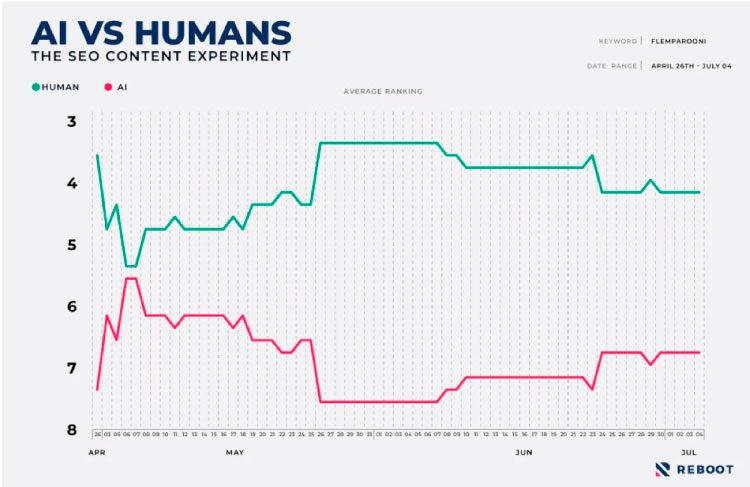
This study confirms what we already saw with the Hotjar study: that the editor is still necessary and that human editors have an advantage over AI in many aspects:
“Part of providing the people-centric content our readers deserve is giving them up-to-date, actionable information that helps them do their jobs. With AI alone, there’s simply no way to do that yet—which means an experienced editor or writer (or both) would still have to get heavily involved. ChatGPT might be a helping hand, but it also needs one.”
However, it should not be forgotten that AI content could perform better if other SERP factors come into play, as Reboot acknowledges: “It is possible that some AI content domains will rank well as a result of other on-site and off-site factors, or the way in which AI is used […].”
This becomes a real possibility if AI is given the right data to answer user queries, which today can only be done with data-driven AI content platforms like Keytrends and not with generic tools.
Read this guide to understand how and create your freemium account to put it into practice now. Although the best thing to do is to schedule a demo with us so that we can show you how to use it in your day-to-day work and ask us all the questions you have ⬇️
From chatbots to data-driven AI co-pilots: Google relies on data to generate content with Genesis
Proof of the need for a shift towards data-driven content with AI is the text generation tool for journalists that Google is reportedly preparing: Genesis.
Although it has not been confirmed or denied by Google, it consists of a news assistant and generator that would be trained to meet the quality standards required by the media.
According to the New York Times, Genesis would completely dissociate itself from the current problems of generative AI:
➡️ It could obtain information and event data in real time to speed up the writing of news stories.
➡️ It could personalise the generated content by providing a choice of writing styles.
➡️ It could automate writing tasks, giving ideas and helping choosing the title and headline structure.
If this is the case, and taking into account the features of Google’s upcoming AI tools, Genesis could do away with AI content as we know it now, subject to the hallucinations and impersonal style of OpenAI’s GPT model.
Even so, it would not be intended to replace news editors, as Google stated in a press release when Genesis was just an idea:
“The company says that solutions like ‘Genesis’ are far from a substitute for journalists and editors. While such apps can be useful for generating more engaging headlines or fine-tuning a text with tests on different writing styles, “they are simply not intended to replace, and cannot replace, the essential role that journalists play in reporting, creating and fact-checking their articles,” Google explains in its press release.
How we got here: the evolution since the first chats
This is a natural and necessary step for generative text, the result of the evolution that has taken place since the emergence of ChatGPT. From it, we moved on to more innovative tools that could connect to the internet, give sources and draft (YouChat), to gradually give way to assistants or co-drivers that give personalised recommendations (Perplexity.ai) and interact with the pages that were being visited (Bing).
Genesis is just a taste of what the next generation of data-driven AI copilots will be able to do. Two come from Google itself, Bard and Duet AI, and the other will be Microsoft 365 Copilot. Bard will be embedded in the search engine (the new Search Generative Experience) and will connect with Google applications such as Sheets or Docs to generate content with the help of Bard and online information. For the time being, this is already possible in the English market thanks to the extensions that have been introduced.
Microsoft 365 Copilot and Duet AI will be the first to not only feed off the data they find on the internet and the databases, but will process the user’s or company’s own data to generate new information. Microsoft 365 Copilot will connect with Word, Excel, PowerPoint, Outlook, Teams and more. And Duet AI will connect with all Workspace apps and those of external companies such as Asana, Hubspot and Tableau:
Generic text generators vs. AI data-driven content platforms
Just as chatbots have given way to co-pilots capable of interacting with our data, AI text generators (also known as AI writers or AI copywriters) have also evolved into more sophisticated tools or platforms based on data and not just ChatGPT.
Difference between the two types of tools for creating AI content
To understand the difference, we must first look at simple generators. These are specific tools for writing content that allow the user to write any type of text based on models or templates that have a programmed prompt behind them:
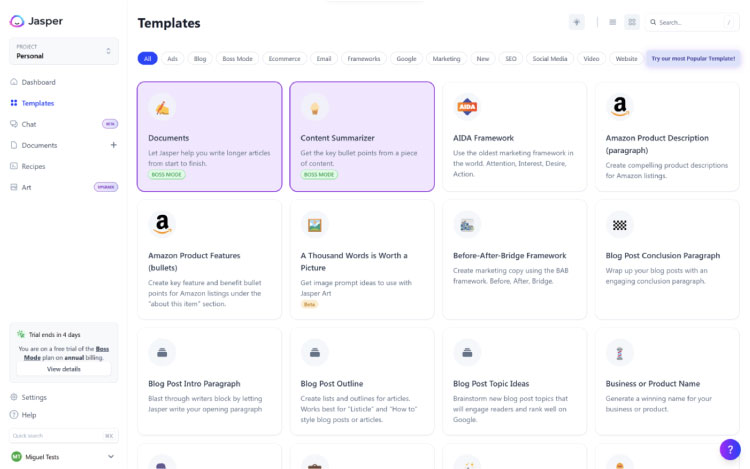
All you have to do is tell the tool some minimum information such as the type of audience, the medium, the language and the desired tone (for example, appeal to readers of a Spanish-language blog with a friendly or informal tone).
The way it works is the same for the hundreds of AI copywriters that have appeared: Ryrt, Quopywriter, Jasper.ai… Some have greatly improved their performance through specialisation, as Copysmith in mass text generation for ecommerce, or Writer in the creation of content in corporate environments. Others have incorporated internet connectivity, such as Closers Copy, Escríbelo o Copy.ai, to offer in real time what it positions in SERPs.
However, they still have a big problem, and that is that they do not extract user searches in order to study the search intent.
3 main problems with generic AI text tools
But that’s not the only thing they fail at. Most generic tools for creating AI content have these 3 main problems:
- Limited technology: most are based on ChatGPT and replicate its problems.
Many AI writers or copywriters are built with ChatGPT’s technology, using of its API. This means that they will have the same problems as this chatbot (hallucinations, lack of reference sources, false or biased data, generic writing style and prompt-dependency..) , with some exceptions:
- You train your own language model from scratch: this means being able to choose the databases from which you will learn and adjust the characteristics of the answers.
- A fine-tuning process is applied to the GPT model: the same as above, but applied to the OpenAI GPT model.
As they specialise in content marketing and SEO, these are the two solutions of choice and even combine data-driven AI content platforms. On the other hand the generic tools are limited to working with ChatGPT because they are designed for copy. In the latter case, human involvement is essential, while in the former, the level of involvement is much lower.
- Not all AI tools are connected to the internet: they are outdated and do not provide SERP-oriented information
Like OpenAI’s chatbot, the generic AI text generators that work with ChatGPT do not connect to the internet (except for those that pay for the Plus version, available in the US), so they cannot extract recent information from the SERPs. In addition to this, the most recent information that ChatGPT has been trained with is from 2021, which makes it impossible to generate content about a recent topic or one that arose after that year (the paid versions do not have this limitation).
How can you generate a SEO article that ranks without being able to access information from the SERPs that responds to the different search intentions of users at a given time?
Without connecting to the internet and the SERPs in real time you can’t, because the content will include headings, keywords and information that were in place until 2021, but not in real time. Again, this is something that data-driven AI platforms like keytrends specialised in content marketing and SEO do, which go much further and allow you to investigate the full search intent (we’ll see).
- Failure to create SEO-optimised content that meets search intent
Tapping into the SERPs to research competitors’ headings and dragging them into the text is only part of researching user search intent, and it’s the most that some generic AI writers allow you to do.
So the question is, where are the questions people have around a topic ?, where are the associated terms they use and the related SEO entities? These are some of the data that is needed to create a 100% SEO optimised article that matches both, he user and the search engines.
That is to say, a content that covers the search intention and at the same time is working on the semantics to be found and positioned by Google. But this is not all that is important to work on content. The strategy that surrounds it is the springboard to the SERPs of not just a page, but an entire website.
And this is where AI and data-driven content platforms like Keytrends give us so much more. Read this guide to understand how and create your freemium account to put it into practice now. Although the best thing to do is to schedule a demo with us so we can show you how you could use it in your day to day life and ask us all the questions you need ⬇️
AI data-driven Content Platforms: user-centered content with strategy
The same thing happening with AI text generators is going on with platforms: not all of them are the same or have the same approach, and most of them have evolved along with generative AI and the market. In Keytrends ourselves we started with only 3 features and now we offer more than 10 (and we are optimising them)!
Still, in general, we can say that AI data-driven content platforms have common features and advantages such as:
✔️ Advanced technology: GPT + proprietary LLMs + fine tuning
✔️ Variety of SERPs and user research data
✔️ Generation of user-centered SEO briefings and articles
✔️ Semantic optimisation of content from entities
✔️ Detection of new content topics and opportunities
✔️ Monitoring and improvement of existing content
✔️ Strategy management and planning
Each platform focuses on some of these features and others, such as Keytrends, offer all the functionality needed to cover the entire workflow of a content strategy, including AI research and creation. Let’s look at some of them in more detail.
Examples of content marketing platforms based on AI + data
- Wordlift:
Wordlift is a platform and plugin for WordPress that helps the writer and/or editor to work on semantic SEO writing based on natural language or NLG (Natural Language Generation).
It does this thanks to its own AI that creates a Knowledge Graph for each project with the aim of creating a content strategy in which the optimised articles are interrelated thanks to the semantic context. This context is achieved through the use of SEO entities and structured data that the tool itself identifies and suggests.
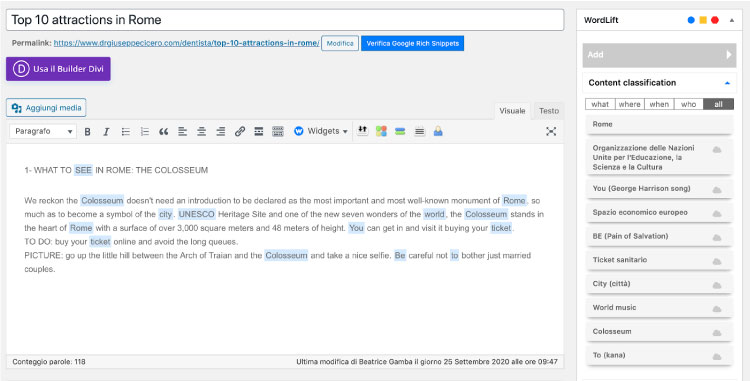
Their content generator is very different from others because it creates customised prompts from that graph and a fine-tuned language model: “The tool uses a dynamic prompt generated using the data from your knowledge graph and a fine-tuned model customised to align with your brand’s specific examples. This customisation ensures the generated content maintains a consistent tone and style per your brand’s identity“.
This ensures that the texts created always follow the same verbal identity of the project. In short, Wordlift provides what no other generic content generator does: semantic SEO optimisation + positive user experience with the text. We’ll tell you how we incorporate the entities later!
- Frase.io
Frase focuses its platform on researching and generating content and SEO briefings based on SERP data. This includes the content of positioned competitors (headings and texts of each section), but also data from user searches.
From the latter, 3 types of queries can be extracted: Google AAPs, Reddit and Quora, leaving out other related searches and suggested keywords. While the information is being researched, it can be dragged into the drag and drop editor, just as we do in Keytrends. See how research is done with Frase.io.
The writing is done in the same way as the other generators: you can choose text templates (predefined prompts for titles, paragraphs, introductions, conclusions, social media posts, ad copies…), actions such as expanding or summarising text and optionally, enter the instruction or prompt for each section of the article.
Finally, it has an optimisation section to include missing keywords (but not entities), reference sources and include internal linking. In short: the basic and necessary to create optimised content (a bit lacking in entities) but without features to work on the overall strategy, just like Wordlift.
- MarketMuse
MarketMuse’s strength is the data it extracts from the competition to find content opportunities. It detects keywords and topics that other sites don’t cover so that you can generate your own content that is missing in the SERPs with its briefing generator and editor (the writing works with pure ChatGPT).
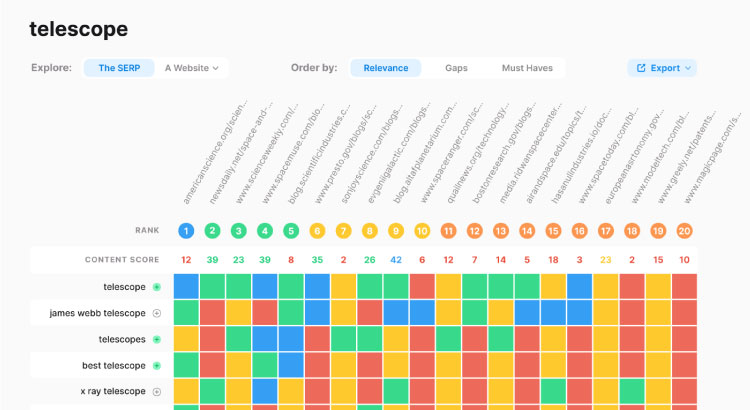
It is a platform that is starting to approach what we do, which is to work on several of the processes involved in a content strategy. It allows you to do keyword research, create topics clusters and plan the content in an editorial calendar to have the whole strategy under control.
Keytrends: plataforma AI data-driven para crear contenido optimizado para las personas
When we were born our obsession was to automate all content strategy tasks. To do so, we had two assets: artificial intelligence and data. As we wanted to help companies generate people-first content, we decided to merge the two (and our slogan helpful content for people with AI was born):
➡️ Our data: we use data from Google Trends, Google Ads, Search Console, Entities, Google SERPs and more to detect opportunities and trends, content topics, research competitors and extract keywords and queries. But we also use internal data from your projects to detect cannibalisation, analyse your traffic and tell you which pages you can improve to be more visible online.
➡️ Our AI: we start with the 3.5 Turbo version of ChatGPT and refine the prompts. We chained sequences of commands to improve the responses and deal with all those limitations of OpenAI’s generative AI. In some cases, such as ecommerce descriptions and other specific cases, we apply fine-tunning.
➡️ Our aim: to help you generate content with powered AI and to help to create your content strategy improving your content decisions
1. Generate content with enhanced AI with 3 x more data than others.
As we’ve seen throughout this guide, text templates that generate content from a ChatGPT prompt don’t work without a clear search intent to cover. With Keytrends you can research your user and competitors in an assisted way with all the Google data, SERPs and user data you need without leaving the platform:
Search suggestions
Suggested searches by letter, proportion and question
Related questions
Questions asked by users in relation to a topic
Competitors headings
Positioned competitor headings
Related searches
Searches related to keyword principal
SEO entities
Extracted with different algorithms, also for News & Images
With all this data you can create a complete SEO briefing. As an extra, you can work on your authority by adding E-E-A-T reference sources from real papers, and link to other content of your own thanks to the fact that we connect with your project to generate an automatic internal linking based on entities. Then, you have three options to write your text:
- Use the +30 predefined text templates or prompts by adding some AI instructions.
- Use Keychat, our adapted version of ChatGPT.
- Let the AI automatically write the article based on the information you have found (you can also let it do its own research and come up with content that you can then edit). In this case, all you have to do is click a button, and the magic happens.
The possibilities of an AI writer with all this information are enormous, and the result has nothing to do with that offered by generic tools, because you respond directly to what users are looking for and optimise the content according to what already exists in the SERPs. Watch it in action in this video:
2. Use data to create your content strategy and make content decisions.
At Keytrends, data drives every content decision you make at every stage of your strategy work:
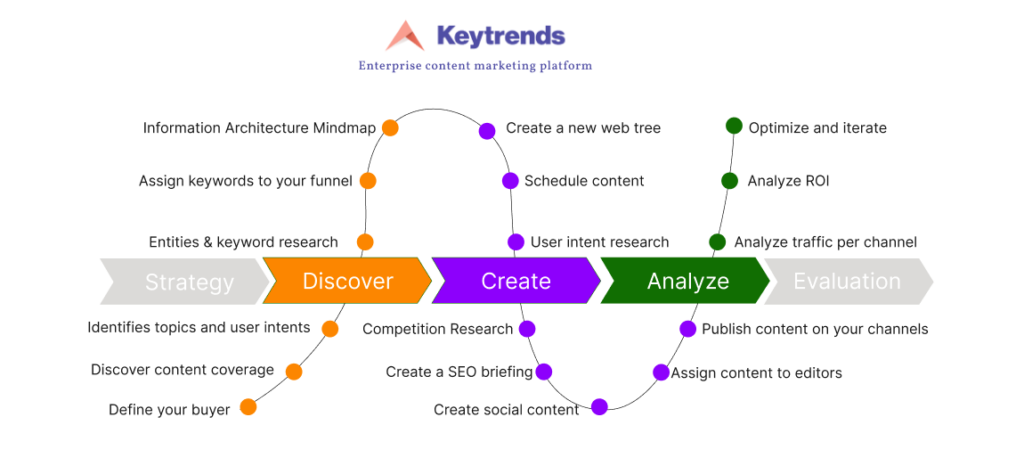
In a nutshell, these are the 3 main questions you will ask yourself during the development of your content strategy, and how you will be able to solve them with the help of the data and functions of our platform:
| 📃 What topics do I already cover? | ✏️ What can I write about? | 📈 What are my results and how can I improve? |
✓ Check your calendar and the status of your planned content in the Publishers Panel. ✓ Cannibalisation function to check all your contents that share a keyword ✓ All the data of your pages integrating your Search Console | ✓ Use Trend Discovery to catch real-time growing trends ✓ Discover the top timeless or evergreen content topics in your industry ✓ Do a complete entities & keywords research | ✓ Check the ranking of each content with data from Search Console ✓ Use the Score as a guide to detect opportunities in your content. ✓ Re-optimise with Optimizer and Copilot function |
As you can see, you can do a 360º job on your strategy: check what content you already have, decide what new content to create, manage it with your team, then review the results and re-optimise to improve when necessary. All this would not be possible without a data-driven approach and the power of AI to research 10 times faster and write in 1 click.
With all this information, it is now up to you to make your choice:
🅰️ Use various content automation and AI tools to cover the entire workflow of your strategy.
🅱️ Unify all your processes into a single platform specifically for content marketing, powered by AI and drawing on multiple data sources to create unique and valuable content for your users. Remember our motto: helpful content for people with AI.
To find out more, you can read the resource we created about the best type of tool to optimise your content budget (because yes, money matters too!).
As always, we close this guide with an outline photo of everything we have seen:
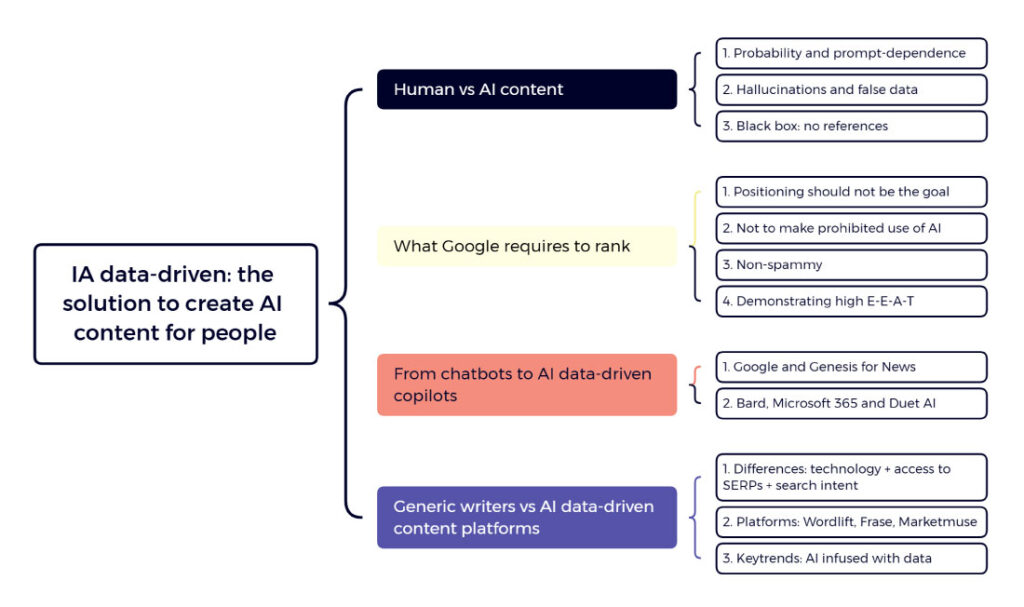
Will our prediction come true and in the future we will only see data-driven AI text tools? If, like us, you are already ahead of us and are using one of them, leave us your impressions in the comments (who knows, maybe they will inspire us for a new feature). If not, create your freemium account to put it into practice now!
Although the best thing to do is to schedule a demo with us so we can show you how you could use it in your day-to-day life and ask us all the questions you need ⬇️
References:
- AI vs Humans – The SEO Content Experiment – Reboot online. (2023, 13 septiembre). https://www.rebootonline.com/blog/ai-vs-humans-content-writing-seo-experiment/
- AI Writer vs. Human Writer: A Content Marketing experiment. (2023, 27 julio). https://www.hotjar.com/blog/ai-vs-human/
- Alkaissi, H., & McFarlane, S. I. (2023). Artificial Hallucinations in ChatGPT: Implications in Scientific Writing. Cureus. https://doi.org/10.7759/cureus.35179
- Bing Webmaster Tools. (s. f.). Webmasters. https://www.bing.com/webmasters/help/webmaster-guidelines-30fba23a
- Blackburn, J. (2023, 10 agosto). 10 helpful ways to use Bard. Google. https://blog.google/products/bard/how-to-use-google-bard/
- Create useful, reliable and people-centred content at the heart of Google search. (s. f.). Google for Developers. https://developers.google.com/search/docs/fundamentals/creating-helpful-content?hl=en#how-the-content-was-created
- Generative AI Prohibited Use Policy. (s. f.). Privacy & Terms – Google. https://policies.google.com/terms/generative-ai/use-policy
- Google Search’s helpful content System | Google Search Central. (s. f.). Google for Developers. https://developers.google.com/search/updates/helpful-content-update?hl=en
- Google Search Guide to AI-generated content | Google Search Centre Blog| Google for Developers. (s. f.). Google for Developers. https://developers.google.com/search/blog/2023/02/google-search-and-ai-content?hl=en
- Mullin, B., & Grant, N. (2023, 20 julio). Google tests A.I. tool that is able to write news articles. The New York Times. https://www.nytimes.com/2023/07/19/business/google-artificial-intelligence-news-articles.html
- Pichai, S. (2023, 6 febrero). An important next step on our AI journey. Google. https://blog.google/technology/ai/bard-google-ai-search-updates/
- Políticas de spam de la búsqueda web de Google | Centro de la búsqueda de Google. (s. f.). Google for Developers. https://developers.google.com/search/docs/essentials/spam-policies?hl=en#spammy-automatically-generated-content
- Shoaib, G. M. (2022, 15 agosto). AI-Based content vs. human created content: Which is the best option? Medium. https://becominghuman.ai/ai-based-content-vs-human-created-content-which-is-the-best-option-3e5078de4edf
- TELUS International. (2023, 6 julio). Generative AI hallucinations: Explanation and Prevention. TELUS International. https://www.telusinternational.com/insights/ai-data/article/generative-ai-hallucinations
